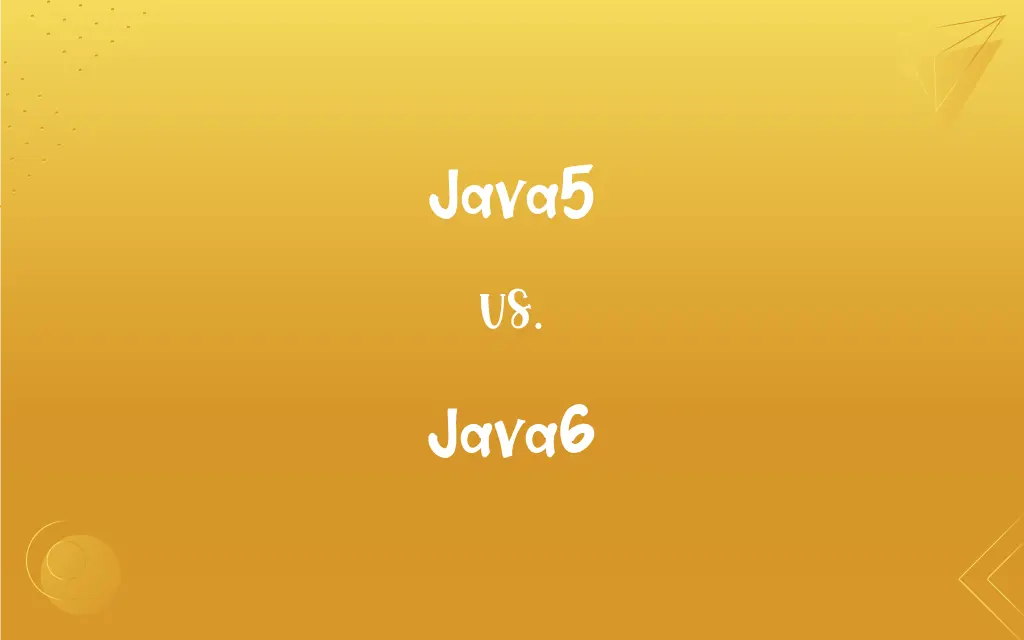Java5 vs. Java6: What's the Difference?
Edited by Aimie Carlson || By Janet White || Published on February 5, 2024
Java5 introduced generics, annotations, and enhanced for-loop; Java6 focused on performance improvements and GUI enhancements.

Key Differences
Java5 introduced generics, allowing type-safe collections and eliminating casting, while Java6 enhanced scripting support with the inclusion of the Java Compiler API, facilitating the use of scripting languages.
Java5 brought annotations, simplifying configuration and metadata; Java6 improved web services support through the introduction of more APIs, enhancing SOAP and RESTful service creation.
While Java5 improved JVM performance and introduced the enhanced for-loop, Java6 went further with JIT compiler enhancements and introduced a consistent look and feel across platforms with the Nimbus Look and Feel for GUIs.
Java5 added significant concurrency utilities in the java.util.concurrent package. Java6 built upon this by enhancing JVM diagnostics and monitoring capabilities, aiding in performance tuning and problem analysis.
Java5 revised the memory model for better thread support and introduced varargs. Java6, on the other hand, provided improvements in the Java compiler for better optimization and code processing efficiency.
ADVERTISEMENT
Comparison Chart
Generics
Introduced generics for type safety.
Enhanced generics with improved type inference.
Annotations
Added annotations for metadata.
Expanded annotation processing capabilities.
For-Loop
Enhanced for-loop for collections.
Optimized loop performance.
Memory Model
Revised memory model for threading.
Improved garbage collection and memory management.
Compiler Enhancements
Introduced varargs and metadata.
Compiler optimizations and processing improvements.
ADVERTISEMENT
Java5 and Java6 Definitions
Java5
Java5 included new concurrency utilities.
Java5 made multithreading easier with its concurrency utilities.
Java6
Java6 improved web services capabilities.
Building web services became more efficient with Java6.
Java5
Java5 introduced generics for type-safe collections.
Java5's generics ensure type safety without casting.
Java6
Java6 focused on performance optimizations.
Java6 significantly improved application performance.
Java5
Java5 added annotations for simplified metadata management.
Using Java5, annotations streamlined configuration processes.
Java6
Java6 enhanced support for scripting languages.
Java6's scripting API opened new possibilities for developers.
Java5
Java5 introduced varargs for flexible argument passing.
Varargs in Java5 simplified methods with variable arguments.
Java6
Java6 introduced Nimbus Look and Feel for GUIs.
Java6's Nimbus transformed the user interface experience.
Java5
Java5 featured an enhanced for-loop for collections.
The enhanced for-loop in Java5 simplified array iteration.
Java6
Java6 enhanced JVM diagnostics and monitoring.
Java6 made it easier to diagnose performance issues.
FAQs
What major improvements did Java6 bring?
Java6 brought performance optimizations and GUI enhancements.
What is Java5 known for?
loops.
Did Java5 change the way collections are used?
safe.
How did Java5 improve concurrency handling?
Java5 added concurrency utilities in the java.util.concurrent package.
Was there any change in memory management from Java5 to Java6?
Yes, Java6 improved garbage collection and memory management over Java5's revised memory model.
What enhancements did Java6 make to the Java compiler?
Java6 improved the compiler for better optimization and efficiency.
Did Java6 make any changes to Java5's generics?
Java6 improved upon Java5's generics with better type inference.
How did Java6 improve scripting capabilities?
Java6 enhanced scripting support with the Java Compiler API.
Did Java6 introduce any new GUI features?
Yes, Java6 introduced the Nimbus Look and Feel for GUIs.
What are annotations in Java5?
Annotations in Java5 are used for metadata representation.
What are the key differences in threading between Java5 and Java6?
Java5 introduced a new threading model, while Java6 offered improved thread handling and diagnostics.
What is varargs in Java5?
Varargs in Java5 allow methods to accept variable numbers of arguments.
How did Java6 impact web services development?
Java6 introduced more APIs, enhancing SOAP and RESTful web service creation.
Can you explain Java5's concurrency utilities?
Java5's concurrency utilities provided tools for managing threads efficiently.
How did Java6's compiler enhancements differ from Java5's?
Java6's compiler enhancements focused on optimization, while Java5 introduced new features like varargs and annotations.
What role did annotations play in Java5?
Annotations in Java5 provided a way to associate metadata with code elements.
How did Java5 improve type safety?
Java5's introduction of generics greatly improved type safety in collections.
What GUI improvements were made in Java6?
Java6 introduced the Nimbus Look and Feel, offering a modern, cross-platform GUI appearance.
loop benefit developers?
It simplified iterating over collections and arrays in Java5.
Did Java6 offer any specific tools for diagnostics and monitoring?
Yes, Java6 enhanced JVM diagnostics and monitoring tools for better performance analysis.
About Author
Written by
Janet WhiteJanet White has been an esteemed writer and blogger for Difference Wiki. Holding a Master's degree in Science and Medical Journalism from the prestigious Boston University, she has consistently demonstrated her expertise and passion for her field. When she's not immersed in her work, Janet relishes her time exercising, delving into a good book, and cherishing moments with friends and family.
Edited by
Aimie CarlsonAimie Carlson, holding a master's degree in English literature, is a fervent English language enthusiast. She lends her writing talents to Difference Wiki, a prominent website that specializes in comparisons, offering readers insightful analyses that both captivate and inform.






































































